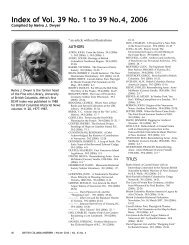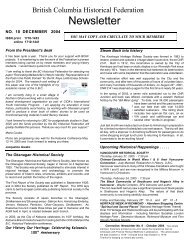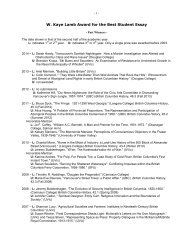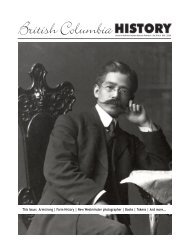bc historic news - BC Historical Federation
bc historic news - BC Historical Federation
bc historic news - BC Historical Federation
You also want an ePaper? Increase the reach of your titles
YUMPU automatically turns print PDFs into web optimized ePapers that Google loves.
the death of Joynson. Both were charged with murder,and committed to stand trial. Wilson died in his cellon October 30, leading the Vancouver press tospeculate pointedly that he “may have received otherinjuries.” Wilson, in fact, died as the result of a severeinfection. He had carried a bullet in his shoulder formore than three weeks. As a result, Smith would standtrial alone. Two weeks later, Smith went before Mr.Justice Murphy. He pleaded not guilty to the murderof Joynson, but the full weight of evidence was againsthim. Not only did the statements of the guardsimplicate him, one former convict testified that he wasin the yard and witnessed the two shots from Smith’srevolver strike the victim.The case went to the jury November 16, andafter deliberating three hours they returned with averdict of guilty of one count of murder. Mr. JusticeMurphy faced Smith, “Have you anything to say whythe sentence of this court should not be passed uponyou?”“No sir,” Smith said, shaking his head.“The sentence of this court therefore is, that youshall be taken from hence to the place from whichyou came, there to be kept in close confinement untilthe 31st day of January next, when you shall be takenfrom thence to the place of execution and hanged bythe neck until dead. And may God have mercy onyour soul.”While prisoners awaiting death sentences wereusually housed in provincial institutions, where thesentences were carried out, Smith was to remain atthe New Westminster penitentiary. The reason, prisonauthorities claimed, was that it was simply easier toleave him where he was being housed. In fact, Smith’sexecution would serve as an example to the otherprisoners. The scaffold was erected near the placewhere John Henry Joynson had been shot: an obviousmessage for any prisoner contemplating violenceagainst the guards.At 8:20 on the morning of Friday, January 31,1913, Joseph Smith, with his hands bound behind hisback, began his slow walk to the gallows. Rather thanthe distinctive garb of a prisoner, Smith wore a plainblue shirt. No coat protected him from the winter chill.In the procession were prison officials, guards, thesheriff and Smith’s spiritual advisor, Reverend J. S.Henderson. The minister offered his arm in support,but Smith needed no assistance. He walked with hishead upright to the scaffold where the Dominionhangman waited silently. The prisoners had been keptlocked up that morning. Whether they could hear oreven see the execution from their cells was never madeclear. Once the prisoner was on the platform, theexecutioner brought down a hood covering the man’sface. Smith was maneuvered over the trap. The noosewas lowered and tied in place. Reverend Hendersonbegan reciting the Lord’s Prayer. He reached only “onearth as it is in Heaven” when the trap sprang. Smithfell through the door and out of sight. Although thefall broke his neck, it took 13 minutes for his pulse tostop. Smith was interred in a remote corner of theprison’s burial grounds. He was the only prisoner tobe executed within what was to become one of themost violent penitentiaries in Canada.Looking ahead to 1980, another group of prisonofficials gathers on a different platform for thepenitentiary’s closing ceremony. Those familiar withthe old institution have no difficulty drawing a parallelbetween events. After more than half a century, anotherdeath sentence has been carried out. •BRITISH COLUMBIA HISTORY - Vol. 39 No. 1 15







